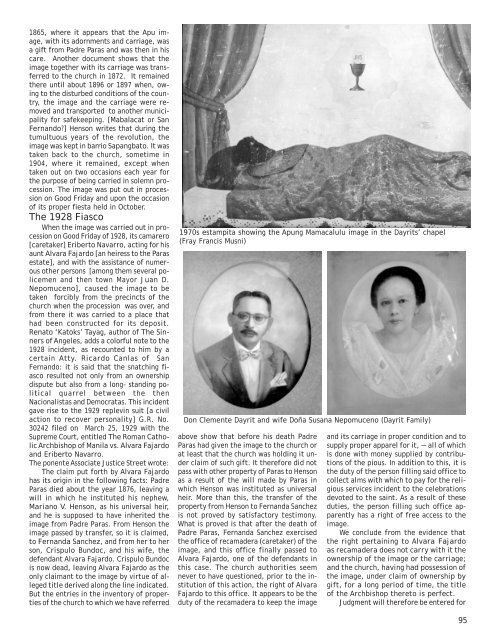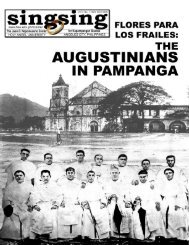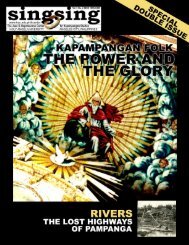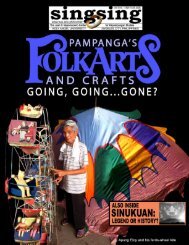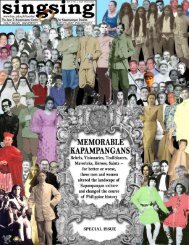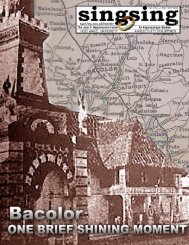Download PDF - Holy Angel University
Download PDF - Holy Angel University
Download PDF - Holy Angel University
You also want an ePaper? Increase the reach of your titles
YUMPU automatically turns print PDFs into web optimized ePapers that Google loves.
1865, where it appears that the Apu image,<br />
with its adornments and carriage, was<br />
a gift from Padre Paras and was then in his<br />
care. Another document shows that the<br />
image together with its carriage was transferred<br />
to the church in 1872. It remained<br />
there until about 1896 or 1897 when, owing<br />
to the disturbed conditions of the country,<br />
the image and the carriage were removed<br />
and transported to another municipality<br />
for safekeeping. [Mabalacat or San<br />
Fernando?] Henson writes that during the<br />
tumultuous years of the revolution, the<br />
image was kept in barrio Sapangbato. It was<br />
taken back to the church, sometime in<br />
1904, where it remained, except when<br />
taken out on two occasions each year for<br />
the purpose of being carried in solemn procession.<br />
The image was put out in procession<br />
on Good Friday and upon the occasion<br />
of its proper fiesta held in October.<br />
The 1928 Fiasco<br />
When the image was carried out in procession<br />
on Good Friday of 1928, its camarero<br />
[caretaker] Eriberto Navarro, acting for his<br />
aunt Alvara Fajardo [an heiress to the Paras<br />
estate], and with the assistance of numerous<br />
other persons [among them several policemen<br />
and then town Mayor Juan D.<br />
Nepomuceno], caused the image to be<br />
taken forcibly from the precincts of the<br />
church when the procession was over, and<br />
from there it was carried to a place that<br />
had been constructed for its deposit.<br />
Renato ‘Katoks’ Tayag, author of The Sinners<br />
of <strong>Angel</strong>es, adds a colorful note to the<br />
1928 incident, as recounted to him by a<br />
certain Atty. Ricardo Canlas of San<br />
Fernando: it is said that the snatching fiasco<br />
resulted not only from an ownership<br />
dispute but also from a long- standing political<br />
quarrel between the then<br />
Nacionalistas and Democratas. This incident<br />
gave rise to the 1929 replevin suit [a civil<br />
action to recover personality] G.R. No.<br />
30242 filed on March 25, 1929 with the<br />
Supreme Court, entitled The Roman Catholic<br />
Archbishop of Manila vs. Alvara Fajardo<br />
and Eriberto Navarro.<br />
The ponente Associate Justice Street wrote:<br />
The claim put forth by Alvara Fajardo<br />
has its origin in the following facts: Padre<br />
Paras died about the year 1876, leaving a<br />
will in which he instituted his nephew,<br />
Mariano V. Henson, as his universal heir,<br />
and he is supposed to have inherited the<br />
image from Padre Paras. From Henson the<br />
image passed by transfer, so it is claimed,<br />
to Fernanda Sanchez, and from her to her<br />
son, Crispulo Bundoc, and his wife, the<br />
defendant Alvara Fajardo. Crispulo Bundoc<br />
is now dead, leaving Alvara Fajardo as the<br />
only claimant to the image by virtue of alleged<br />
title derived along the line indicated.<br />
But the entries in the inventory of properties<br />
of the church to which we have referred<br />
1970s estampita showing the Apung Mamacalulu image in the Dayrits’ chapel<br />
(Fray Francis Musni)<br />
Don Clemente Dayrit and wife Doña Susana Nepomuceno (Dayrit Family)<br />
above show that before his death Padre<br />
Paras had given the image to the church or<br />
at least that the church was holding it under<br />
claim of such gift. It therefore did not<br />
pass with other property of Paras to Henson<br />
as a result of the will made by Paras in<br />
which Henson was instituted as universal<br />
heir. More than this, the transfer of the<br />
property from Henson to Fernanda Sanchez<br />
is not proved by satisfactory testimony.<br />
What is proved is that after the death of<br />
Padre Paras, Fernanda Sanchez exercised<br />
the office of recamadera (caretaker) of the<br />
image, and this office finally passed to<br />
Alvara Fajardo, one of the defendants in<br />
this case. The church authorities seem<br />
never to have questioned, prior to the institution<br />
of this action, the right of Alvara<br />
Fajardo to this office. It appears to be the<br />
duty of the recamadera to keep the image<br />
and its carriage in proper condition and to<br />
supply proper apparel for it, — all of which<br />
is done with money supplied by contributions<br />
of the pious. In addition to this, it is<br />
the duty of the person filling said office to<br />
collect alms with which to pay for the religious<br />
services incident to the celebrations<br />
devoted to the saint. As a result of these<br />
duties, the person filling such office apparently<br />
has a right of free access to the<br />
image.<br />
We conclude from the evidence that<br />
the right pertaining to Alvara Fajardo<br />
as recamadera does not carry with it the<br />
ownership of the image or the carriage;<br />
and the church, having had possession of<br />
the image, under claim of ownership by<br />
gift, for a long period of time, the title<br />
of the Archbishop thereto is perfect.<br />
Judgment will therefore be entered for<br />
95


